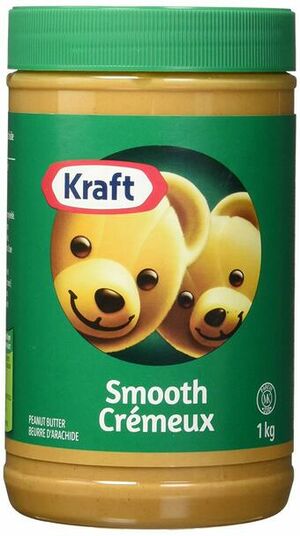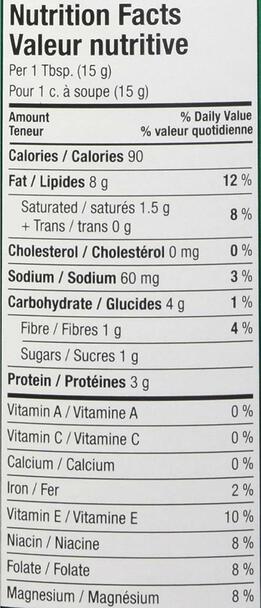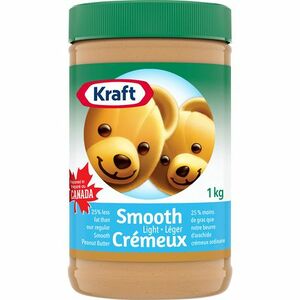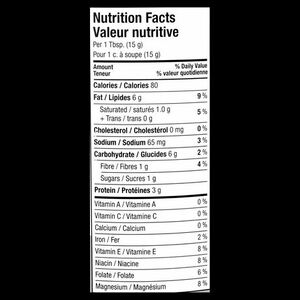Course:FNH200/Assignments/2021/Kraft Peanut Butter VS. Kraft Light Peanut Butter (25% less fat)
Peanut Butter is a mixture made from dried roasted peanuts that is seen as a global favourite when it comes to spreadable food products. With the help of many other ingredients, peanut butter provides a very nutty and nutritious addition to many simple meals from sandwiches to a base for a sauce.
Kraft Peanut Butter - Smooth and Kraft Light Peanut Butter (25% less fat) - Smooth are the two products we have chosen to compare and contrast. This is a well loved brand when it comes to peanut butter and it's widely available to most individuals at a reasonable price in supermarkets, corner stores, or from online. For packaging, the two do not have any striking differences besides the label clarification that one is Light while the other is the Original.
In this page, we will outline and analyze the differences and similarities within the products and how the change of ingredients affect the overall product with the differences.[1]
Product Images pictures






Throughout this page, you will see images of the products we will be discussing with the labels outlining all of their ingredients and nutritious value
*We do not own these images. They have been referenced fro online resources. The use of these images are strictly for academic purpose. Please refer to the citations or the hyperlink.*
Ingredient lists
| Ingredients | Identify fat substitutes, sugar substitutes, additives | Explain their roles, and what they contribute to the product |
|---|---|---|
| Select Roasted Peanuts | Base Ingredient | Main ingredient |
| Soybean oil | Base Ingredient | Adds smoothness and prevents the natural oils found in peanuts from separating and rising to the top. |
| Corn Maltodextrin (or Maltrin) | Fat Substitutes | Corn Maltodextrin is a fat substitute that yields 4kcal/g compared to regular fat that yields 9kcal/g. It is also a thickening agent that increases the viscosity of the peanut butter, provides body, and enhances the suspension of particles within the peanut butter. It contains a preservative function to increase the shelf life of the product and prevent early onset of spoilage. |
| Sugar | Base Ingredient | Adds sweetness to the peanut butter. |
| Hydrogented Vegetable Oil[8] (Cotton Seed and Rapseed Oil) | Additive | Hydrogenated Vegetable Oil is an emulsifier that stabilizes the structure, helps to improve the texture and consistency of the peanut butter, and preventing the separation of the natural peanut oils from the peanut paste. It is a preservative that makes the product more resistant to fat oxidation and thus increasing its shelf life. |
| Mono- and Diglycerides | Fat Substitutes | Mono and Diglycerides are emulsifiers that assist the mixture of water and oil in an emulsion by orienting themselves to minimize the interface tension between the two phases. This works to stabilize the product and ensuring equal distribution throughout the mixture by the dispersion of one phase into the second continuous phase. |
| Salt | Base Ingredient | Enhances the flavour. |
| Ingredients | Identify fat substitutes, sugar substitutes, additives[9] | Explain their roles, and what they contribute to the product |
|---|---|---|
| Select Roasted Peanuts | Base Ingredient | Main ingredient. |
| Corn Maltodextrin | Fat Substitutes | Corn Maltodextrin is a fat substitute that yields 4kcal/g compared to regular fat that yields 9kcal/g. It is also a thickening agent that increases the viscosity of the peanut butter, provides body, and enhances the suspension of particles within the peanut butter. It contains a preservative function to increase the shelf life of the product and prevent the early onset of spoilage.[10] |
| Sugar | Base Ingredeint | Adds sweetness to the peanut butter. |
| Soybean Oil | Base Ingredient | Adds smoothness and prevents the natural oils found in peanuts from separating and rising to the top. |
| Hydrogented Vegetable Oil (Cotton Seed and Rapseed Oil) | Additive | Hydrogenated Vegetable Oil is an emulsifier that stabilizes the structure, helps to improve the texture and consistency of the peanut butter, and preventing the separation of the natural peanut oils from the peanut paste. It is a preservative that makes the product more resistant to fat oxidation and thus increasing its shelf life.[11] |
| Mono- and Diglycerides | Fat Substitues | Mono and Diglycerides are emulsifiers that assist the mixture of water and oil in an emulsion by orienting themselves to minimize the interface tension between the two phases. This works to stabilize the product and ensuring equal distribution throughout the mixture by the dispersion of one phase into the second continuous phase.[12] |
| Salt | Base Ingredient | Enhances the flavour. |
All the ingredients in each product are listed above. Both Kraft Peanut Butter - Smooth and Kraft Light Peanut Butter (25% Less Fat) - Smooth share the same list of ingredients. While that doesn't provide clarity as to why one has lower fat content than the former, it is the actual amount of each ingredient in the peanut butter itself that creates the difference between each product.
Ingredients in products in Canada are listed in order of weight, with the ingredient that weighs the most in the beginning and the ingredient that weighs the least in the end. When comparing the two products, it was found that there is less soybean oil and more salt in the Kraft Light Peanut Butter (25% less fat) - Smooth compared to the regular Kraft Peanut Butter - Smooth .
Labels:
- Kraft Smooth (Crémeux)
- Product: Peanut Butter
- Brand: KraftCanada
- Origin: Canada
- Ingredients:
- Select roasted peanuts, Soybean oil, Sugars (corn maltodextrin, sugar), Hydrogenated vegetable oil (cottonseed and rapeseed oil), salt, Mono- and Diglycerides.
- Nutritional Value:
- Kraft Smooth (Crémeux) 90 Calories per 15g: Fat 8g (10%)-Saturated Fat 1.5g (7%); Carbohydrate 3g-Fibre 1g (3%)-Sugars 1g (1%); Protein 3g; Sodium 65mg (3%); Potassium 75mg (2%); Calcium 10mg (1%); Iron 0.4mg (2%)
- Ingredients:
- Kraft Smooth Light (Léger Crémeux)
- Product: Peanut Butter
- Brand: KraftCanada
- Origin: Canada
- Ingredients:
- Select roasted peanuts, Soybean oil, Sugars (corn maltodextrin, sugar), Hydrogenated vegetable oil (cottonseed and rapeseed oil), salt, Mono- and Diglycerides.
- Nutritional Value:
- Kraft Smooth Light (Léger Crémeux) 80 Calories per 15g: Fat 6g (7%)-Saturated Fat 1g (4%); Carbohydrate 5g-Fibre 1g (3%)-Sugars 1g (1%); Protein 3g; Sodium 65mg (3%); Potassium 75mg (2%); Calcium 10mg (1%); Iron 0.5mg (3%) 1kg
- Ingredients:
*The following information comply with the regulatory requirements for packaging and labelling of food. They also comply with the information and regulatory requirement outlined in Lesson 04.*
The information on the labels of each product are included below:
- Bilingual Labelling: French and English
- Common Name of the Food: Peanut Butter
- Name of the Business: KraftCanada
- Country of Origin: Canada
- Identity and Principal Place of Business (whether we can contact KraftCanada): Yes
- Legibility and location (Are you able to read the label? Are the font sizes legible? Is the information easy to locate on the packaging?) Yes
- List of ingredients in descending order of proportion: Yes
- The Nutrition Facts table (the Calories, the amount of fat, saturated and trans fats, cholesterol, sodium, carbohydrate, fiber, sugars, protein, calcium, iron and Vitamins A and C): Yes
- Net quantity of the food: Yes
- Date marking and storage instructions(for foods with a storage life of 90 days or less) (we cannot find the exact date because we cannot see the bottom of the peanut butter, but it writes “see the expiry date at the bottom”): Yes
- Common Allergens: Peanut
The information below is required on food labels but it is not a requirement on our chosen products:
- Other mandatory information: (eg. % alcohol for alcoholic beverages, % milk fat for some dairy products): N/A
- Nutrient content claims and diet-related health claims: N/A
- Irradiated foods: N/A
- Sweeteners: N/A
*Our information is based off of the Consumer Packaging and Labelling Act and Regulations and can be found on the CFIA website*
References
Please use the Wikipedia reference style. Provide a citation for every sentence, statement, thought, or bit of data not your own, giving the author, year, AND page.
Note: Before writing your wiki article on the UBC Wiki, it may be helpful to review the tips in Wikipedia: Writing better articles.[13]
- ↑ [www.sciencedirect.com "Hydrogenated Oils - an overview | ScienceDirect Topics"] Check
|url=value (help). Science Direct. 2017.|first=missing|last=(help) - ↑ "Smooth Kraft Peanut Butter".
- ↑ "Smooth Kraft Peanut Butter - Label Zoomed In".
- ↑ "Smooth Kraft Peanut Butter - Label".
- ↑ "Smooth Light Kraft Peanut Butter".
- ↑ "Smooth Light Kraft Peanut Butter - Label".
- ↑ "Smooth Light Peanut Butter - Label Zoomed In".
- ↑ [www.medicalnewstoday.com "Hydrogenated oil: What is it? Is it bad? Learn more here"] Check
|url=value (help). July 20, 2021. - ↑ Health, Canada (October 29, 2012). [www.canada.ca "Lists of permitted Food Additives"] Check
|url=value (help). - ↑ Chan, Judy. (2021) 2.2.1.1 "Carbohydrates". Canvas. Retrieved July 18, 2021.
- ↑ Chan, Judy. (2021) 2.2.1.2 "Fats and Oils". Canvas. Retrieved July 18, 2021.
- ↑ Chan, Judy. (2021) 2.2.1.2 "Fats and Oils". Canvas. Retrieved July 18, 2021.
- ↑ En.wikipedia.org. (2018). Writing better articles. [online] Available at: https://en.wikipedia.org/wiki/Wikipedia:Writing_better_articles [Accessed 18 Jan. 2018].
| This Food Science resource was created by Course:FNH200. |
